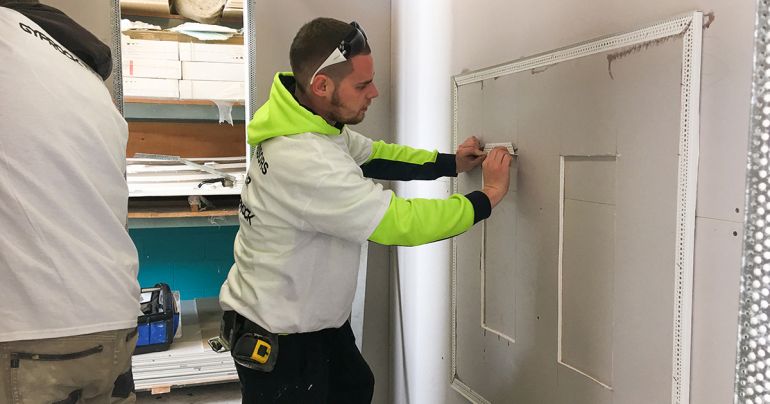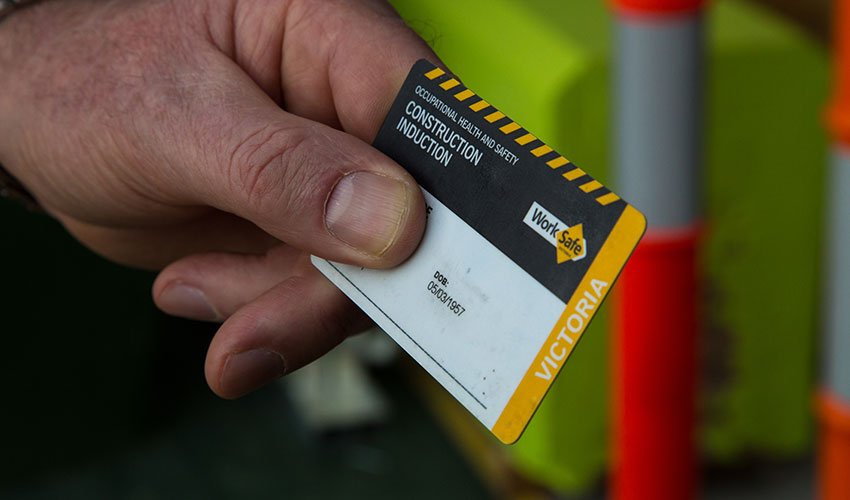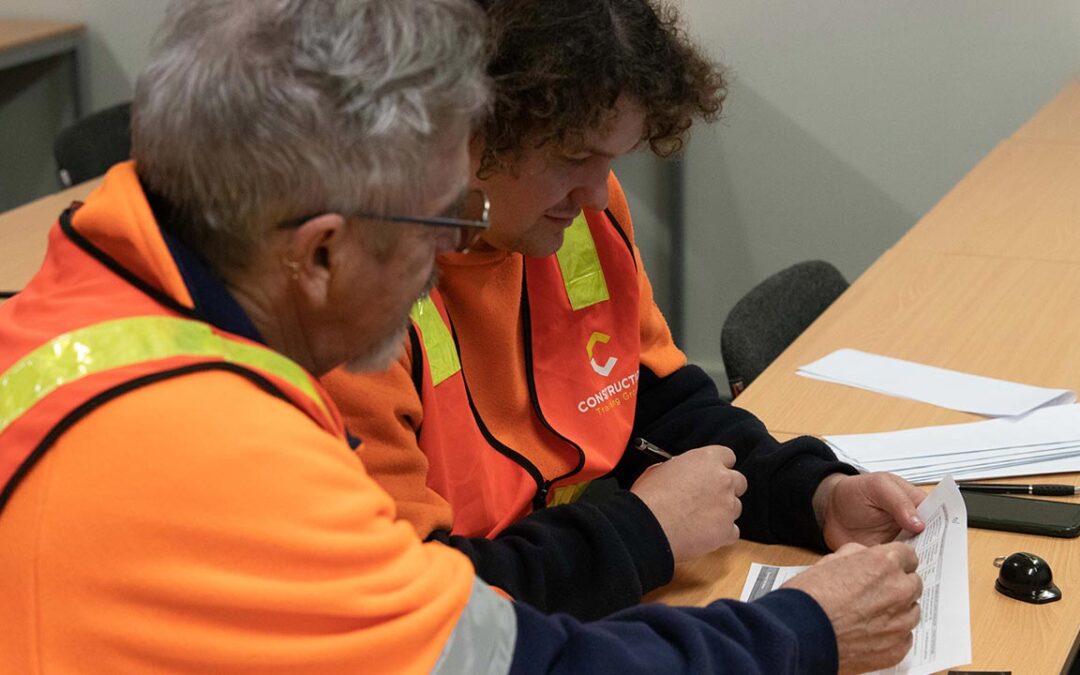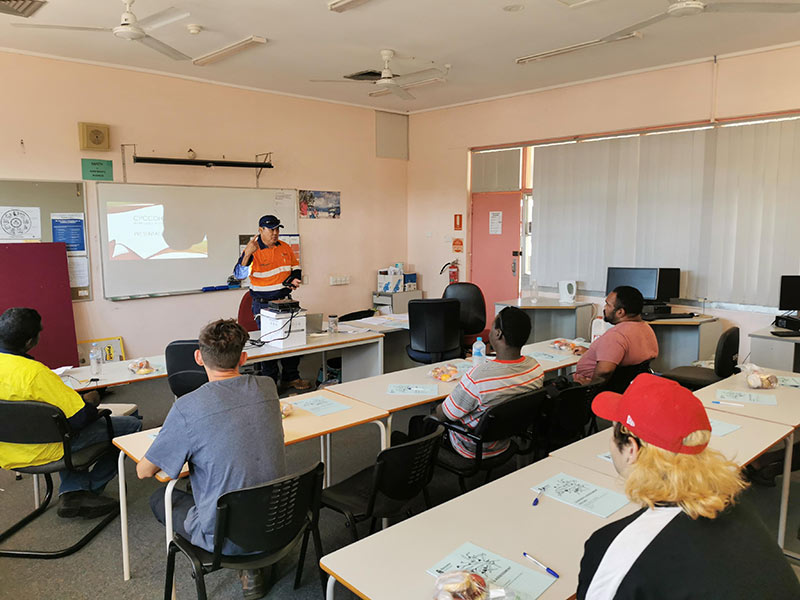
by admin | Oct 4, 2024 | blog
Introduction
In Australia, workplace safety is paramount, particularly in the construction industry, where workers are often exposed to various hazards. The White Card Course, or Construction Induction Training, plays a critical role in promoting safety and health standards across construction sites. This certification is mandatory for anyone wishing to work in construction and ensures that workers are equipped with the necessary knowledge and skills to identify hazards, assess risks, and implement safety measures. This article explores how the White Card Course effectively ensures safety within the construction industry.
The Foundation of the White Card Course
1. Overview of the White Card Course
The White Card Course is a nationally recognized training program that covers essential safety information required for construction workers. This course is designed to educate participants about their rights and responsibilities regarding workplace safety and to ensure compliance with the Work Health and Safety (WHS) Act. Upon completion, participants receive a White Card, which is proof of their understanding of safety protocols and procedures.
2. Legal Requirements
Under the WHS legislation, all construction workers must complete the White Card Course before they can legally work on construction sites. This requirement ensures that everyone entering a construction site possesses a fundamental understanding of safety regulations and practices. By mandating this training, regulatory bodies aim to minimize accidents and injuries, ultimately fostering a safer work environment.
Key Safety Topics Covered in the Course
1. Work Health and Safety Legislation
Understanding the legal framework surrounding workplace safety is a vital component of the White Card Course. Participants learn about the WHS Act, the roles of various stakeholders, and the responsibilities of employers and employees in maintaining a safe work environment. This knowledge empowers workers to advocate for their safety rights and encourages a culture of accountability on construction sites. Whether you’re aiming to work on large commercial projects or residential developments like display homes, having a White Card is an essential first step.
2. Hazard Identification and Risk Assessment
One of the primary focuses of the White Card Course is hazard identification and risk assessment. Participants are taught to recognize potential hazards on construction sites, such as:
Physical Hazards: These include machinery, tools, scaffolding, and uneven surfaces.
Chemical Hazards: Participants learn about the safe handling of hazardous substances, including chemicals and solvents.
Biological Hazards: Awareness of potential exposure to infectious diseases or mold is also addressed.
By teaching workers to identify these hazards, the course helps them understand how to assess the associated risks and implement control measures to mitigate them. This proactive approach to safety is essential in preventing accidents and injuries.
3. Safe Work Practices
The White Card Course emphasizes the importance of safe work practices. Participants learn about:
Personal Protective Equipment (PPE): The course covers the types of PPE required on construction sites, such as helmets, gloves, safety glasses, and high-visibility clothing. Understanding how to properly use and maintain PPE is crucial for personal safety.
Safe Use of Tools and Machinery: Workers receive training on the correct and safe operation of tools and machinery, including forklifts, scaffolding, and power tools. This training minimizes the risk of accidents caused by improper usage.
Manual Handling Techniques: Participants are educated on proper lifting techniques and ergonomics to prevent injuries related to manual handling, such as strains and sprains.
By instilling safe work practices, the White Card Course equips workers with the skills needed to perform their jobs safely and efficiently.

How the White Card Course Ensures Safety
4. Emergency Procedures
Preparedness for emergencies is a critical aspect of workplace safety. The White Card Course teaches participants how to respond to various emergencies, including:
Fire Emergencies: Understanding fire safety protocols, including evacuation procedures and the use of fire extinguishers.
Medical Emergencies: Recognizing medical emergencies and knowing how to provide basic first aid or seek help when needed.
Site Evacuations: Learning evacuation routes and procedures to ensure a safe and orderly exit during emergencies.
By providing this training, the White Card Course ensures that workers are ready to respond effectively to emergencies, minimizing potential harm to themselves and their colleagues.
1. Building a Safety Culture
The White Card Course fosters a culture of safety within the construction industry. By training workers to prioritize safety and understand their roles in maintaining a safe work environment, the course encourages a collective commitment to safety practices. This culture helps reduce the number of accidents and injuries on construction sites.
2. Enhancing Communication Skills
Effective communication is essential for ensuring safety on construction sites. The White Card Course teaches participants how to communicate hazards and safety protocols clearly. This includes reporting unsafe conditions, discussing safety measures with colleagues, and participating in safety meetings. Improved communication fosters a safer work environment by ensuring that everyone is informed and aware of potential risks.
3. Encouraging Continuous Learning
The construction industry is constantly evolving, with new technologies, techniques, and regulations emerging regularly. The White Card Course promotes continuous learning by emphasizing the importance of staying updated on safety practices and regulations. Participants are encouraged to refresh their knowledge periodically, ensuring they remain informed about the latest safety standards and practices.
Conclusion
The White Card Course is a vital component of workplace safety in the Australian construction industry. By providing comprehensive training on safety legislation, hazard identification, risk assessment, safe work practices, and emergency procedures, the course equips workers with the knowledge and skills necessary to create a safe working environment.
With the mandatory requirement for all construction workers to complete the White Card Course, the industry is better positioned to minimize accidents and injuries. By fostering a culture of safety, enhancing communication skills, and encouraging continuous learning, the White Card Course ultimately contributes to the well-being of all workers in the construction sector.
Whether you are just starting your career in construction or are an experienced worker looking to refresh your skills, completing the White Card Course is a crucial step towards ensuring your safety and that of your colleagues. Embrace the opportunity to learn, grow, and contribute to a safer construction industry in Australia.

by admin | Oct 4, 2024 | blog
Navigating Australia’s White Card Course
Introduction
In Australia, the White Card, or Construction Induction Training Card, is an essential certification for anyone wishing to work in the construction industry. This training ensures that workers are knowledgeable about workplace safety and can contribute to a safe working environment. As the construction sector continues to expand, understanding how to navigate the White Card Course is vital for aspiring construction workers. This article will guide you through the course structure, requirements, benefits, and the steps to obtain your White Card. Navigating Australia’s White Card Course
Understanding the White Card Course
1. What is the White Card?
The White Card is a nationally recognized certification that confirms a worker’s completion of the required safety training in the construction industry. It is a legal requirement for anyone working on construction sites across Australia. The training covers various aspects of health and safety, hazard identification, risk assessment, and emergency procedures, ensuring workers are equipped to handle the unique challenges of the construction environment.
2. Why is the White Card Necessary?
The White Card is crucial for several reasons:
Legal Compliance: The Work Health and Safety (WHS) Act mandates that all construction workers complete the White Card training before stepping onto a construction site. This ensures that everyone on site understands their responsibilities regarding safety.
Safety Awareness: The course helps workers recognize hazards, assess risks, and implement safe practices. This awareness is vital in reducing accidents and injuries, ultimately fostering a culture of safety on site.
Employment Opportunities: Many employers require candidates to have a White Card before hiring them. Possessing this certification not only improves your chances of securing a job but may also enhance your earning potential.
The Structure of the White Card Course
1. Course Content
The White Card Course is designed to provide participants with comprehensive training on various topics, including:
Work Health and Safety Legislation: Understanding the legal framework governing workplace safety and the responsibilities of employers and employees.
Hazard Identification and Risk Management: Learning to identify potential hazards, assess risks, and implement appropriate control measures to mitigate those risks.
Safe Work Practices: Gaining knowledge about personal protective equipment (PPE), safe use of tools and machinery, and adherence to safety protocols.
Emergency Procedures: Understanding how to respond to emergencies, including evacuation plans, incident reporting, and first aid basics.
Communication Skills: Developing effective communication strategies for reporting hazards and ensuring safety information is shared among team members.
2. Delivery Methods
The White Card Course can be delivered through various formats, including:
Face-to-Face Training: This traditional method involves in-person classes led by qualified trainers. Participants can engage in discussions, ask questions, and participate in group activities.
Online Training: Many Registered Training Organizations (RTOs) offer online courses, allowing participants to complete the training at their own pace. This format is ideal for those with busy schedules or those living in remote areas.
Blended Learning: Some RTOs provide a combination of online and face-to-face training, allowing participants to benefit from both methods. This approach offers flexibility while still providing opportunities for interactive learning.
Steps to Obtain Your White Card
1. Choose a Registered Training Organization (RTO)

Navigating Australia’s White Card Course
The first step in obtaining your White Card is selecting a registered training organization that offers the White Card Course. Ensure the RTO is recognized by the relevant authorities to issue valid White Cards. Research various providers to find one that meets your needs, considering factors such as course format, schedule, and fees.
2. Check Course Availability
After selecting an RTO, review their course schedule and availability. Many organizations offer multiple sessions, including weekends and evenings, to accommodate different learners. Make sure to choose a time that suits your schedule.
Once you have chosen an RTO and identified a suitable course, complete the enrollment process. This typically involves filling out an application form and paying the course fee. Be sure to compare fees among different RTOs to find a course that fits your budget.
4. Attend the Course
Upon enrollment, attend the course sessions as scheduled. Actively participate in discussions, ask questions, and complete any assessments required. Engaging with the material will enhance your understanding and help you retain important information.
5. Complete Assessments
Most RTOs require participants to complete assessments to demonstrate their understanding of the course content. These assessments may include quizzes, practical exercises, or group activities. Successfully completing these assessments is essential to obtain your White Card.
6. Receive Your White Card
After successfully completing the course and assessments, you will receive your White Card. This certification is valid for life, although it is advisable to refresh your knowledge periodically, especially if you are not actively working in the industry.
Benefits of Completing the White Card Course
1. Increased Safety Knowledge
The White Card Course equips you with the knowledge and skills to identify hazards and implement safety measures on construction sites. This understanding contributes to a safer work environment for you and your colleagues, reducing the risk of accidents and injuries.
2. Enhanced Employability
Possessing a White Card makes you a more attractive candidate to potential employers. Many construction companies prioritize hiring workers who have completed the White Card training, as it demonstrates a commitment to safety and professionalism. Additionally, some employers may offer better pay or benefits to those with a White Card.
3. Networking Opportunities
Participating in the White Card Course provides an opportunity to connect with other aspiring construction workers and industry professionals. Building a network can lead to job opportunities, mentorship, and valuable industry insights.
4. Confidence in Your Skills
Completing the White Card Course enhances your confidence in your ability to work safely and effectively on construction sites. This confidence is essential for navigating the challenges of the industry and ensuring your own safety as well as that of your colleagues.
Conclusion
Navigating Australia’s White Card Course is a crucial step for anyone aspiring to work in the construction industry. By understanding the course structure, requirements, and benefits, you can better prepare yourself for this important training. Obtaining your White Card not only fulfills a legal requirement but also equips you with the skills and knowledge necessary to contribute to a safe working environment.
As the construction industry continues to grow, having a White Card will enhance your employability and provide you with valuable skills that will serve you throughout your career. Take the necessary steps to enroll in the White Card Course, and embark on your journey towards a successful and safe career in construction.

by admin | Oct 3, 2024 | blog
Why You Need a White Card in Australia
Introduction
In Australia, the White Card is a mandatory requirement for anyone looking to work in the construction industry. This certification not only demonstrates that you have completed the necessary training in health and safety practices, but it also serves as proof of your commitment to creating a safe working environment. With safety being a paramount concern in construction, understanding the significance of the White Card is crucial for all workers. In this article, we will explore why obtaining a White Card is essential, the benefits it offers, and the key components of the training involved.
What is a White Card?
The White Card, officially known as the Construction Induction Training Card, is a certification that indicates a worker’s understanding of workplace health and safety standards within the construction environment. It is a legal requirement for anyone who wishes to work on construction sites across Australia. The White Card is recognized nationally, ensuring that workers meet the same safety standards regardless of their location in the country.
The Importance of the White Card
1. Legal Requirement
One of the primary reasons you need a White Card is that it is a legal requirement in Australia. The Work Health and Safety (WHS) legislation mandates that all construction workers must complete a nationally recognized training program to be eligible to work on site. This law protects both workers and employers by ensuring that everyone on a construction site is trained in safe work practices. Without a White Card, you cannot legally work on a construction site, which limits your job opportunities in the industry.
2. Promoting a Safe Work Environment
Safety is the cornerstone of the construction industry. The White Card Course provides participants with essential training on identifying hazards, assessing risks, and implementing safety measures. By obtaining your White Card, you are contributing to a safer work environment for yourself and your colleagues. Understanding how to recognize potential dangers and knowing how to respond can significantly reduce the likelihood of accidents and injuries on site.
3. Enhanced Employment Opportunities
In today’s competitive job market, having a White Card can set you apart from other candidates. Many employers require job applicants to hold a valid White Card before considering them for positions on construction sites. By obtaining this certification, you enhance your employability and increase your chances of securing a job in the construction industry. Additionally, some employers may offer better pay or benefits to those who hold a White Card, as it reflects a commitment to safety and professionalism.
4. Skills Development
The White Card Course is designed to equip participants with vital skills and knowledge that are applicable in various roles within the construction industry. Participants learn about workplace health and safety legislation, safe work practices, emergency procedures, and communication strategies. This training not only prepares individuals for the specific demands of their jobs but also fosters a culture of safety that benefits everyone on site.
What You Will Learn in the White Card Course
The White Card Course covers a wide range of topics to ensure participants are well-versed in health and safety practices. Here are some key areas of focus:

Why You Need a White Card in Australia
Participants are introduced to the WHS legislation that governs construction work. This includes the responsibilities of employers and workers, the importance of compliance, and the implications of failing to adhere to safety regulations. Understanding these laws is crucial for ensuring a safe working environment.
2. Hazard Identification and Risk Assessment
A significant portion of the course is dedicated to identifying potential hazards in the workplace. Participants learn how to assess risks associated with these hazards and develop control measures to mitigate them. This knowledge empowers workers to proactively address safety concerns before they lead to accidents.
3. Safe Work Practices
The course emphasizes the importance of following safe work practices. Participants learn about the proper use of personal protective equipment (PPE), handling tools and machinery, and adhering to safety protocols. Understanding these practices helps reduce the risk of injury and ensures compliance with workplace safety standards.
4. Emergency Procedures
Knowing how to respond in emergencies is a vital skill for all construction workers. The White Card Course teaches participants about emergency procedures, including evacuation plans, incident reporting, and basic first aid. Being prepared for emergencies can make a significant difference in how incidents are managed and can save lives.
5. Communication and Reporting
Effective communication is crucial in maintaining a safe work environment. Participants learn how to report hazards and unsafe practices, fostering a culture of safety on site. Open communication ensures that safety concerns are addressed promptly, reducing the likelihood of accidents.
How to Obtain Your White Card
Obtaining your White Card is a straightforward process that involves the following steps:
1. Choose a Registered Training Organization (RTO)
The first step is to select a registered training organization (RTO) that offers the White Card Course. It is essential to ensure that the RTO is recognized by the relevant authorities to issue valid White Cards. Research different providers to find one that suits your needs and preferences.
2. Check Course Availability
Once you have chosen an RTO, check their course schedule and availability. Many organizations offer both face-to-face and online training options, providing flexibility for participants. Consider your schedule and choose a format that works best for you.
3. Complete the Enrollment Process
After selecting an RTO, complete the enrollment process. This typically involves filling out an application form and paying the course fee. Fees can vary depending on the provider, so it is advisable to compare costs and choose an option that fits your budget.
4. Attend the Course
Upon enrollment, attend the course sessions as scheduled. Engage actively with the material, participate in discussions, and complete any assessments. Your commitment to learning will enhance your understanding of the content and prepare you for the assessment.
5. Receive Your White Card
After successfully completing the course and assessments, you will receive your White Card. Keep this certification safe, as you will need to present it to employers when applying for jobs in the construction industry.
Conclusion
In summary, obtaining a White Card is essential for anyone looking to work in the construction industry in Australia. This certification not only fulfills a legal requirement but also promotes safety and enhances employment opportunities. By completing the White Card Course, you gain vital skills and knowledge that contribute to a safer work environment. With the construction industry continuing to grow, obtaining your White Card is a crucial step towards a successful career in this dynamic field.
With the knowledge gained from the White Card Course, you are better equipped to navigate the challenges of the construction industry while ensuring your safety and the safety of those around you.

by admin | Oct 3, 2024 | blog
Your Guide to the White Card Course
Introduction to the White Card Course
The White Card Course, also known as the Construction Induction Training Course, is an essential requirement for anyone wishing to work on construction sites in Australia. This course is designed to provide participants with the knowledge and skills needed to work safely and effectively in the construction industry. With safety being a paramount concern in this sector, understanding the principles taught in this course is vital for all workers. Your Guide to the White Card Course
The White Card certification is recognized nationally and is required by law in Australia for all construction workers. This article will explore what the White Card Course entails, the benefits of obtaining it, the course content, how to enroll, and frequently asked questions.
What Is the White Card?
The White Card is a certification that demonstrates a worker’s understanding of workplace health and safety in the construction environment. It signifies that the holder has completed the necessary training to work safely on construction sites and is aware of their responsibilities under the Work Health and Safety (WHS) legislation.
This card is often a prerequisite for various roles within the construction industry, including tradespeople, laborers, site managers, and supervisors. Without a valid White Card, individuals cannot legally work on construction sites, making it a critical qualification for anyone entering this field.
Benefits of the White Card Course
1. Legal Requirement
One of the primary benefits of obtaining a White Card is that it is a legal requirement for anyone working in construction. Employers are obligated to ensure that their workers hold a valid White Card before allowing them on-site. By completing the course, individuals comply with legal obligations and avoid penalties associated with non-compliance.
2. Safety Awareness
The course equips participants with vital knowledge about workplace safety, including identifying hazards, understanding risk assessment, and implementing safety procedures. This awareness contributes to creating a safer work environment, reducing the likelihood of accidents and injuries.
3. Improved Employment Opportunities
Having a White Card enhances employability in the construction industry. Many employers prefer or require candidates to have this certification, making it a valuable asset when applying for jobs. Additionally, some roles may demand additional training, but having a White Card is often the first step in building a successful career in construction.
4. Enhanced Skills and Knowledge
The White Card Course provides participants with essential skills and knowledge that can be applied in various roles. This includes understanding safety protocols, emergency procedures, and the correct use of personal protective equipment (PPE). The knowledge gained from the course can lead to better job performance and increased confidence on-site.
Course Content Overview
The White Card Course covers a range of topics to ensure participants gain a comprehensive understanding of workplace health and safety in construction. Below are the key topics typically included in the training:
1. Understanding Work Health and Safety Legislation
Participants learn about the relevant WHS legislation that governs construction sites. This includes the duties of employers and workers, rights and responsibilities, and the importance of complying with legal requirements.

Your Guide to the White Card Course
A significant focus of the course is on identifying potential hazards in the workplace, including physical, chemical, and environmental risks. Participants are taught how to assess these risks and implement control measures to minimize them.
3. Safe Work Practices
The course emphasizes the importance of safe work practices, including proper handling of equipment, use of PPE, and adherence to safety protocols. Participants learn about best practices for working at heights, operating machinery, and working in confined spaces.
4. Emergency Procedures
Knowing how to respond in an emergency is crucial for all workers. The course covers emergency procedures, including evacuation plans, reporting incidents, and administering basic first aid. Understanding these procedures can save lives in critical situations.
5. Reporting and Communication
Effective communication is essential for maintaining a safe workplace. Participants learn how to report hazards, incidents, and unsafe practices. This training fosters a culture of safety where workers feel empowered to communicate concerns without fear of retaliation.
How to Enroll in the White Card Course
Enrolling in the White Card Course is a straightforward process. Here are the steps to follow:
1. Choose a Registered Training Organization (RTO)
The first step is to select a registered training organization (RTO) that offers the White Card Course. It is crucial to ensure that the RTO is recognized by the relevant authorities to issue valid White Cards.
2. Check Course Availability
Once you have identified an RTO, check their course schedule and availability. Many organizations offer both face-to-face and online training options, providing flexibility to suit your needs.
3. Complete the Enrollment Process
After choosing an RTO, complete the enrollment process. This typically involves filling out an application form and paying the course fee. Fees can vary depending on the provider, so it is advisable to compare costs.
4. Attend the Course
Upon enrollment, attend the course sessions as scheduled. Ensure you engage with the material and participate in discussions and practical exercises. This interaction enhances your learning experience.
5. Obtain Your White Card
Upon successful completion of the course and assessment, you will receive your White Card. Keep this card safe, as you will need to present it to employers when applying for jobs in construction.
Frequently Asked Questions (FAQs)
1. How long is the White Card valid?
The White Card does not expire, but it is advisable to stay updated on WHS regulations and practices. Some employers may require periodic refresher courses to ensure workers are aware of current safety protocols.
2. Can I complete the White Card Course online?
Yes, many RTOs offer online options for the White Card Course, allowing you to complete the training at your convenience. Ensure that the online course includes interactive components and assessments to meet the required standards.
3. Is the White Card recognized in all Australian states and territories?
Yes, the White Card is recognized nationally across all states and territories in Australia. Once you obtain your White Card, it is valid for use in any state or territory.
4. What if I lose my White Card?
If you lose your White Card, contact the RTO that issued it. They can guide you through the process of obtaining a replacement.
Conclusion
The White Card Course is a vital training program for anyone seeking to work in the construction industry in Australia. By obtaining this certification, individuals demonstrate their commitment to workplace safety and compliance with legal requirements. With the knowledge gained from the course, workers can contribute to a safer work environment and enhance their employment opportunities within the construction sector.

by admin | Oct 2, 2024 | Education
Understanding the White Card Course
White Card training, formally known as the Construction Induction Training, is a mandatory certification for individuals looking to work in the construction industry in Australia. This course is designed to provide workers with essential knowledge about health and safety regulations, ensuring that they are prepared to recognize and mitigate potential hazards on construction sites. The White Card serves as proof that a worker has completed the necessary training and understands the importance of workplace safety.
The Legislative Background
In Australia, safety regulations in the construction industry are governed by both federal and state laws. The introduction of the White Card course arose from the need to standardize safety practices across various states and territories. It aligns with the Work Health and Safety (WHS) Act and regulations, which aim to protect the health and safety of workers. Each state and territory may have slight variations in their requirements, but the fundamental principles of the White Card training remain consistent nationwide.
Who Needs a White Card?
The White Card is required for anyone who wishes to work on a construction site, including:
Labourers: Those involved in manual work, including site preparation and demolition.
Trade Workers: Electricians, plumbers, carpenters, and other skilled tradespeople.
Supervisors and Managers: Individuals overseeing construction projects must also be certified.
Students and Apprentices: Those training or gaining experience in the construction field.
Obtaining a White Card is often a prerequisite for employment in the construction sector, making it crucial for job seekers in this field.
Key Components of the White Card Training
The White Card course covers various topics critical to maintaining a safe working environment. Some of the key components include:
1. Understanding Hazards and Risks
Participants learn to identify common hazards on construction sites, such as falls, equipment failures, and exposure to harmful substances. The course emphasizes risk assessment techniques, enabling workers to evaluate potential risks and implement appropriate control measures.
2. Personal Protective Equipment (PPE)
The training provides comprehensive information on the types of PPE required on construction sites, including hard hats, gloves, goggles, and safety boots. Workers are educated on the correct usage, maintenance, and limitations of PPE to ensure their effectiveness in preventing injuries.
3. Emergency Procedures
Understanding how to respond in emergencies is a crucial aspect of the White Card training. Workers are trained in emergency protocols, including evacuation procedures, first aid, and how to report incidents effectively. This knowledge is vital for minimizing risks and ensuring a prompt response during emergencies.
4. Workplace Safety Culture
The course fosters an understanding of the importance of safety culture within organizations. Workers learn how to promote safety among their peers and the significance of reporting unsafe practices or conditions. This proactive approach contributes to a safer working environment for all.
If you’re looking to enhance your workplace safety culture and ensure compliance with Australian regulations, consulting with experienced Melbourne safety consultants can provide valuable insights and practical solutions tailored to your business needs.

The Importance of White Card Training in Australia
Completing the White Card course offers several advantages, both for workers and employers.
1. Enhanced Employment Opportunities
For job seekers, having a White Card can significantly enhance their employability in the construction industry. Many employers require this certification as a minimum standard, making it a valuable asset when applying for jobs. It demonstrates a commitment to safety and an understanding of industry regulations.
2. Increased Workplace Safety
By equipping workers with the necessary knowledge and skills to identify hazards and respond to emergencies, the White Card training contributes to a safer workplace. Fewer accidents mean not only a more productive workforce but also reduced costs associated with workplace injuries and compensation claims.
3. Legal Compliance for Employers
For employers, ensuring that all workers possess a valid White Card is essential for legal compliance. Failure to meet these requirements can result in significant penalties and liabilities. Providing White Card training for employees is an investment in their safety and the company’s reputation.
The Process of Obtaining a White Card
Getting a White Card involves several straightforward steps:
1. Choose a Registered Training Organisation (RTO)
Select a reputable RTO that offers White Card training. It’s essential to ensure that the organization is accredited and recognized by the relevant authorities in your state or territory.
2. Complete the Training
The training is typically delivered through a combination of online modules and in-person sessions. Participants must complete the required coursework and assessments to demonstrate their understanding of the material.
3. Pass the Assessment
At the end of the course, participants must pass an assessment to demonstrate their knowledge and competency in workplace safety practices.
4. Receive Your White Card
Upon successful completion of the training and assessment, participants will receive their White Card, which is valid across Australia. It’s essential to keep this card on hand while working on construction sites.
Conclusion
The importance of White Card training in Australia cannot be overstated. It plays a crucial role in enhancing workplace safety, ensuring legal compliance, and increasing employment opportunities within the construction industry. As construction sites can be hazardous environments, equipping workers with the knowledge and skills to identify and mitigate risks is essential.
For anyone considering a career in construction, completing the White Card course is a vital step toward ensuring a safe and successful future in this dynamic industry.










